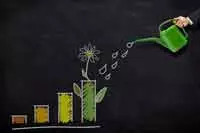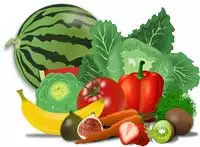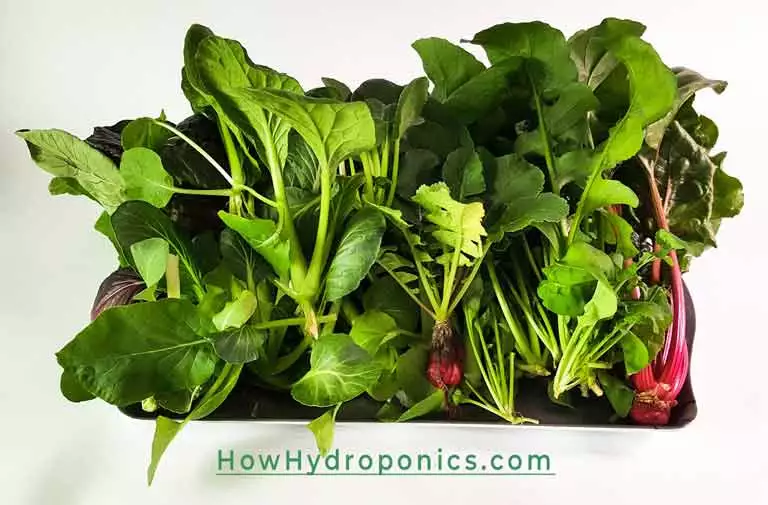You must have heard a lot about how hydroponics is the next big thing in agriculture and how we can build vertical farms within our house or in a comparatively lesser area than the traditional farming method.
Soilless farming or as it is called hydroponics is a type of farming where water-soluble nutrient solution is passed through the roots or the roots are dipped into the nutrient solution itself. This liquid mixture may need to change depending on the type of crop you want to produce or the growth stage. Some benefits of hydroponics can be that it saves water or give organic and fresh fruits and veggies.
When we talk about traditional farming, we imagine big farm fields full of green crops and people doing their usual chores in the field. Ploughing, sowing seeds, reaping the harvest, watering the field, dropping pesticides over the produce to keep it germ-free and what not. So, that is what we know about growing crops in a traditional way. The benefits of hydroponics are that it doesn’t require pesticides or a large piece of land to grow crops, also the time taken is less to harvest the crop. You can start within your house or a balcony for that matter and grow 24 x7.
Let’s talk about the benefits of hydroponics farming and why you should also grow your own crops using hydroponics.
No Farming Land Required
In a world where everyone is concerned about soil erosion and depleting soil quality due to deforestation and commercialisation, hydroponics offers an advanced method of farming that provides better results and is environment friendly for the most part. No farming land is required or so to say you don’t have to own a big chunk of land where you can just plant crops and flowering plants. Instead, you can buy a piece of land, build your own beautiful home, and plant hydroponics on your roof. This is just one of the awesome benefits of hydroponics. Right?
Before hydroponics came into existence traditional farming was the best way we could get produce and fulfil the hunger needs of the human population. But soil farming has some demerits of its own that had to be ignored. But not now. Now you can opt for a much better method called hydroponics or aeroponics for that matter.
Soil farming has some serious limitations, for example, the region you live in determines the type of soil you have, the type of nutrients available to you, which limits the types of crops you can grow at a particular time of the year. Also, you don’t get to know just by looking at a field if the soil is having some kind of disease-causing germs or pests. So, earlier your soil would choose the type of crops you could produce. But now you can get a nutrient solution just perfect for the growth of the plant you want.
95% Water Savings
You must be wondering how can I save water when all that the plant needs is water? What happens in open-field agriculture is that fields are just flooded with water randomly and with no measurement on how much is actually needed. Now as the fields are large most of the water is evaporated from the field before the plant roots could use it.

As per data taken from the U.S Department of Agriculture, roughly 80% of all ground and surface water is used for field irrigation. That means the population of the US consumes just 20% of all the freshwater available. The government spends a huge portion of their budget to develop water-saving irrigation facilities but those are not helping.
As a matter of fact, according to a white paper published in the International Journal of Research in Engineering and Technology, it is mentioned that only 1/20th of the total water is needed to grow the plants in the hydroponic system when compared to open-field agriculture.
That is 95% water saving. Mind-blowing. Right?
Save Electricity
When we talk about irrigating huge fields with fresh and groundwater it requires high power borewells to get that water out from the ground and push it all over the vast area of a farm field. These irrigation pumps consume so much electricity that in some parts of the world the government had to regulate the timings of use of these pumps so that the load could be mitigated on the power grids.
As per the report published by the US department of agriculture, farm business accounts for 41% of total US farms but consumes 90% of the total fuel and electricity consumed by all the farms taken together.
And as the electricity rates are rising in all parts of the US and neighbouring countries it is becoming expensive to water the fields.
In hydroponics, we do use water to deliver the nutrients but as everything is happening in a small space, we tend to provide only that much water that is actually required for optimum growth. So a lot of money is saved by not just spilling water carelessly. Two amazing benefits of hydroponics, it saves money and it saves electricity.
No Space Constraint
This is more of an advantage for the kitchen garden hobbyist or hydroponics enthusiast as it does not require much space to grow crops. What is more amazing is the fact that you can produce a reasonable amount of yield in a small space itself by practising vertical farming. As per research, you can get almost the same quantity of yield hydroponically with just 20% of the total space required to grow crops in an agricultural field.
Moreover as the metropolitan gets more congested and people are always on the go, a nice hanging garden on the balcony is something of pure bliss to get rid of all that urban stress.
Here is a table to get you an idea of how much you can produce hydroponically as compared to traditional farming in the same space.
| Name of the Crop | Hydroponic produce per acre | Agricultural Produce per acre |
| Wheat | 5000 lb | 600 lb |
| Oats | 3000 lb | 850 lb |
| Rice | 12000 lb | 750-900 lb |
| Maize | 8000 lb | 1500 lb |
| Soybean | 1500 lb | 600 lb |
| Potato | 70 tons | 8 tons lb |
| Beet Root | 20000 lb | 9000 lb |
| Cabbage | 18000 lb | 13000 lb |
| Peas | 14000 lb | 2000 lb |
| Tomato | 180 tonnes | 5-10 tons |
| Cauliflower | 30000 lb | 10-15000 lb |
| French Bean | 42000 lb of pods | – |
| Lettuce | 21000 lb | 9000 lb |
| Lady Finger | 19000 lb | 5-8000 lb |
| Cucumber | 28000 lb | 7000 lb |
Quality and Healthy Crops
Now here we cover the health factor of hydroponics. As you all must be knowing that most of the vegetables and fruit that we eat right now comes from fields and farms far off from our homes. We pick them from the nearest grocery store or a Walmart and when they reach you the fruits need to be fresh otherwise no one would buy them right?

So, the manufacturer uses chemicals to keep the fruits fresh and ripe so that he can sell them and make a profit. But when I tell you to set up your own hydroponic garden where you could grow your crops for example spinach or tomatoes, you can enjoy the fresh fruit and it is 100% organic.
Because the consumption happens at the place of produce you get to enjoy the best produce. In the long run that can result in a healthy and sound body and a better lifestyle.
Nutrient Regulation
This is a little technical for beginners but with some experience, it becomes beneficial. What this means for you is that you can regulate the nutrients that you are supplying to your crop. Now in a transitional setup, you would be unaware of what nutrients your plants are getting and just wait and pray that everything comes out to be okay.
Here, you have total control over your crops. You can supply the exact amount of nutrients required for the crop to get the maximum yield and faster growth. Also, the risk of pathogens is less in hydroponics but you do have to take care of the roots or else the crops may be destroyed.
Common diseases in hydroponics are caused by Fusarium and Verticillium. The disease is called wilt. As the occurrence is rare there are not many fungicides available for hydroponics. Heat treatment of your nutrient solution is a way to keep away the pathogens from reaching the roots.
Fast Growth Rate
This one is a no brainer. You give your plants exactly what they need. In terms of the temperature, in terms of the pH level, in terms of the nutrients. Basically, your crops don’t have to do anything but grow. They will grow faster right? Yes.
It has been observed that crops produced hydroponically grow 30 to 60% faster than traditional field crops. Now I have already mentioned the reason for this but wait. One more thing that adds to the faster growth is the fact that you don’t have to plough the field again after reaping your harvest, you don’t have to worry about your soil becoming less nutrient or in some cases becoming toxic. All that you have to do is clean your hydroponic tubes and plant new crops and drain the pipe with fresh nutrient solution.
Technical Knowledge
While we are discussing all the benefits of hydroponics, this one can be both an advantage and a disadvantage. If you are an eternal learner then it is definitely an advantage for you as with hydroponics you have to learn certain skills and read and experiment before you actually start building your own garden. Although a lot of new startups and companies are trying to make the process easier, as with any farming activity, a learning curve is involved with hydroponics too.
There are various parameters to check before sowing the seeds, the number of nutrients required, the pH level of the solution, most importantly the day and night cycle, using grow lights, using the EC meter, and everything can be overwhelming especially for beginners. Hence it is advisable if you are just starting, make sure you do your research, read articles on the internet like this one and pick a plant that is easy to grow. One example could be spinach or any leafy greens as they are considered to be the easiest to grow in a hydroponic system.
Return on Investment
Setting up a hydroponic environment is not that cheap. In the US an average beginner’s hydroponic system would cost somewhere around $200-$300, considering you are getting the full kit from a known hydroponics store. Yes, agreed that the cost is a little high at the beginning but still the return on investment is also high because of the high yield and space maximization you could easily cover up your cost.
Here is a table that will help you approximate the quantity you can grow per square meter of your area.
| Vegetables | Production (g/m2 /day) |
| Carrot | 56.5 |
| Cucumber | 226 |
| Garlic | 57 |
| Ginger | 57 |
| Leek | 57 |
| Green Bean | 113 |
| Lettuce | 226 |
| Onion | 56.5 |
| Peapod | 113 |
| Potato | 56.5 |
| Salad Greens | 226 |
| Tomato | 113 |
| Greens | 113 |
Automated Farming
As most of the setup is controlled electronically, the headache of constantly monitoring the system is taken away. This appeals to a lot of young enthusiasts to try out this method of farming. Once set up you have to monitor the system once a week at midnight. The level of automation depends on the budget you have for your garden. The commercial hydroponic farm uses automated grow lights which mimic the day and night time for the plants. The nutrient diffuser swiftly passes on the nutrients just when the plants require more and a temperature control system keeps the temperature of the nutrient solution optimum for growth.
Hence all this is possible with hydroponic systems and not in the traditional form of farming.
No locational Disadvantage
Not all regions of the world are fortunate enough like the prairies, the soil is not arable in most parts of the world due to volcanic eruptions or saltwater from the ocean. This makes gardening and growing crops for the people living in that region. But with hydroponics no matter where you live you can always grow your own fruits and veggies inside your home, safe from the outer atmosphere.
Hydroponics has demonstrated a successful growth pattern in the dry and humid climates of Israel. Fruits like bananas and citrus-like berries are grown in Israel which is not possible with traditional farming. So, you got my point. The potential is huge with this one.
No Pesticides No Weed
As the plants don’t require soil, they don’t get caught by germs or pests very often. In soil farming, the same soil is used again and again to reap the harvest. To increase yield we use a lot of fertilizers. They do give us results but in the long run, they contaminate the soil. One major effect is that the nitrogen concentration of the soil increases with the regular use of fertilizers. This makes it less fertile and more pest friendly.
In the case of hydroponics, pesticides and weeds do not grow that easily. Although you need to take precautions and keep your systems and nutrient solution clean to prevent the growth of unwanted organisms.
Grow Organic Vegetables and Fruits
As no pesticide is used in growing these crops, these crops are 100% organic and you consume them fresh out of the farm. The benefits are huge. The nutrient solution can be added up with some fertilizers to boost up the growth but you can control the amount of fertilizer or pesticide that you want to feed your plants.
This way you can be totally sure of the purity of your produce. Most engineering and kitchen gardens use hydroponic systems to grow organic fruits and vegetables. The taste of organic fruits is way better than the hybrid ones available in the market.
Grow Multiple Crops
A major limitation with soil farming is that you cannot grow multiple types of crops at the same time. It can be due to the soil quality or because of the temperature, but with hydroponics, you can choose to grow whatever you like whenever you like.
If you wish to grow tomatoes and spinach you could do so by planting tomato seeds in some pots and spinach in the others or a much better idea would be to use separate systems mounted one over the other for different crops. This way you can maximize space as well as variety.

